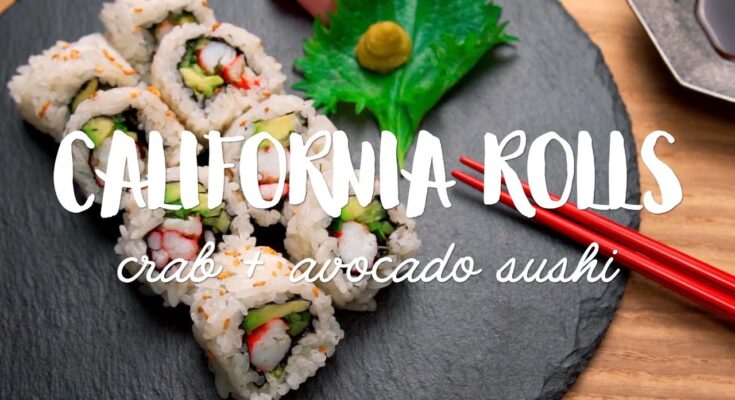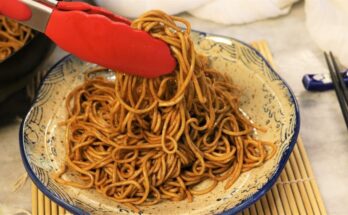California Roll Recipe: The California roll is one of the most popular sushi rolls outside of Japan. Unlike traditional sushi, which usually features raw fish, the California roll is an inside-out roll (uramaki) that contains cooked or imitation crab, creamy avocado, and crisp cucumber. It’s often wrapped in sushi rice on the outside and garnished with sesame seeds or tobiko (fish roe).
This roll is perfect for sushi beginners because it doesn’t include raw seafood and offers a mild, refreshing taste. The balance of textures—from the creamy avocado to the crunch of cucumber—makes every bite incredibly satisfying.
Brief History of the California Roll
Interestingly, the California roll wasn’t born in Japan but rather in Los Angeles, California, during the 1960s or 70s. It’s said that a Japanese chef named Ichiro Mashita created the roll to cater to American palates by replacing raw tuna with avocado and crab, which were more familiar to Western diners.
Since then, it’s become a staple in sushi bars worldwide and is often the first roll people try when they venture into Japanese cuisine. It helped make sushi more mainstream and accessible to people who might have been hesitant to try raw fish.
Ingredients You’ll Need
Core Ingredients
To make a traditional California roll, you’ll need the following:
- 2 cups sushi rice
- 2 ½ cups water
- 1/3 cup rice vinegar
- 2 tablespoons sugar
- 1 teaspoon salt
- 5 sheets of nori (seaweed)
- 1 ripe avocado, sliced
- 1 cucumber, julienned (seedless preferred)
- Imitation crab sticks or real crab meat (about 1 cup)
Optional Add-Ons
These extras can elevate your California rolls:
- Sesame seeds
- Tobiko or masago (fish roe)
- Japanese mayonnaise (for extra creaminess)
- Wasabi and pickled ginger for serving
- Soy sauce for dipping
Tools and Equipment
You won’t need a fancy sushi kitchen, but a few tools help:
- Bamboo sushi rolling mat (makisu)
- Plastic wrap (to prevent sticking)
- Sharp knife
- Rice paddle or wooden spoon
- Bowl of water for wetting hands and knife
Preparing the Ingredients
Cooking and Seasoning Sushi Rice
Sushi rice is the foundation of any good roll. Follow these steps:
- Rinse the rice: Wash the sushi rice under cold water until the water runs clear. This removes excess starch and prevents it from becoming gummy.
- Cook the rice: Combine 2 cups of sushi rice with 2½ cups of water in a rice cooker or saucepan. Cook until tender and let it sit for 10 minutes.
- Season the rice: Mix rice vinegar, sugar, and salt in a small bowl. Gently fold it into the warm rice using a rice paddle or spoon. Be careful not to mash the grains.
- Cool the rice: Spread it on a large flat surface (a tray or wooden bowl) and fan it to cool quickly. This helps achieve the perfect sticky-yet-fluffy texture.
Preparing the Crab and Vegetables
- Imitation crab or real crab meat: Pull apart or slice the crab sticks into thin, manageable strips. If using real crab, flake it and lightly season with a bit of mayo if desired.
- Avocado: Cut the avocado in half, remove the pit, and slice it thinly. A ripe avocado should be creamy and smooth.
- Cucumber: Peel if the skin is tough, then julienne it into thin sticks. Remove seeds to prevent excess water from seeping into the roll.
How to Roll a California Roll
Laying Out the Nori and Rice
- Prepare your station: Place a bamboo rolling mat on a clean surface and cover it with plastic wrap.
- Lay the nori: Place one sheet of nori shiny side down on the mat.
- Spread the rice: Wet your fingers and gently press a thin, even layer of sushi rice over the nori. Cover the entire sheet.
- Add sesame seeds: Sprinkle sesame seeds or tobiko over the rice for flavor and texture.
Adding the Fillings
- Flip it: Carefully flip the nori over so the rice side is down.
- Layer the center: Add crab, avocado slices, and cucumber in a line across the center of the nori. Don’t overfill, or the roll won’t seal well.
Rolling with a Bamboo Mat
- Start the roll: Lift the mat edge closest to you and begin to roll it tightly over the filling, pressing gently but firmly.
- Seal the roll: Once the roll is complete, give it a gentle squeeze to shape it and hold everything together.
- Repeat: Make additional rolls using the same method.
Cutting and Serving
Cutting the Roll Cleanly
- Use a sharp knife: Dip it in water to prevent sticking.
- Cut in half: Slice the roll cleanly in half.
- Cut into six or eight pieces: Wipe the knife between cuts to maintain clean edges.
Plating and Garnishing Ideas
- Arrange slices on a sushi plate with wasabi, pickled ginger, and soy sauce on the side.
- Sprinkle with extra sesame seeds or tobiko for a pop of color.
- Serve with a small bowl of soy sauce for dipping.
Tips for Perfect California Rolls
Choosing the Right Ingredients
When it comes to making California rolls at home, ingredient quality makes all the difference. Use fresh vegetables and ripe avocados. If you can’t find imitation crab sticks, real lump crab meat works beautifully too. For a healthier twist, you can even try brown sushi rice or low-sodium soy sauce. Look for Japanese-style short-grain rice, which becomes perfectly sticky when cooked and is ideal for sushi.
Mastering the Rolling Technique
Rolling sushi might seem intimidating at first, but with a little practice, it becomes second nature. Keep a small bowl of water nearby to dip your fingers and prevent the rice from sticking. When rolling, apply even pressure without squashing the ingredients. Using plastic wrap on the bamboo mat makes cleanup easier and helps create a cleaner roll. Always take your time and enjoy the process—it’s half the fun!
Common Mistakes to Avoid
Using the Wrong Type of Rice
One of the biggest mistakes is using the wrong rice. Long-grain rice, like jasmine or basmati, won’t stick properly. Stick with short-grain or medium-grain Japanese rice specifically labeled for sushi.
Overstuffing the Roll
Tempting as it may be to load your roll with fillings, resist the urge. Overstuffing makes rolling difficult and often leads to tearing. Keep it simple and balanced—just enough filling to taste each ingredient without overpowering the others.
Not Using a Sharp Knife
A dull knife will squish your roll instead of slicing cleanly. Always use a very sharp knife and wet it slightly before each cut. This little trick ensures clean, precise slices without mess.
Health Benefits of California Rolls
Low in Calories and Packed with Nutrients
California rolls are a relatively healthy sushi choice. They’re low in calories and fat (especially if you skip the mayo), and full of fiber from the cucumber and avocado. Avocados are rich in heart-healthy fats and potassium, while crab meat adds lean protein.
A Great Option for Sushi Beginners
Because California rolls are made with cooked or imitation seafood, they’re an ideal introduction to sushi for those who are hesitant about raw fish. It’s a gentle, flavorful entry into the world of Japanese cuisine that’s both satisfying and nutritious.
Fun Variations to Try
Spicy California Roll
Add a kick by mixing your crab meat with a bit of spicy mayo or sriracha. This gives the roll a bold flavor without overpowering the freshness of the avocado and cucumber.
California Roll Bowl
Short on time or don’t want to deal with rolling? Turn your ingredients into a sushi bowl. Just layer sushi rice in a bowl, top with crab, avocado, cucumber, sesame seeds, and a drizzle of soy sauce or spicy mayo.
Tempura California Roll
Want some crunch? Roll the whole California roll in panko breadcrumbs and flash-fry it for a crispy, golden outside. This tempura-style roll is a favorite at many sushi bars.
Storing Leftover California Rolls
Best Practices
Sushi is best eaten fresh, but if you have leftovers, wrap them tightly in plastic wrap and store in the fridge. Place them in an airtight container to retain moisture. Ideally, consume within 24 hours.
Reheating Tips (If Needed)
While sushi isn’t meant to be reheated, if you made a tempura or baked version of the roll, you can briefly warm it in the oven. Avoid microwaving regular sushi, as it can turn the rice rubbery and ruin the texture.
FAQs about California Roll Recipe
Q1: What’s in a traditional California roll?
A classic California roll is made with sushi rice, seaweed (nori), imitation crab (or real crab), avocado, and cucumber. It’s rolled inside-out and often topped with sesame seeds or tobiko.
Q2: Do I need raw fish for a California roll?
Nope! That’s the beauty of it. California rolls are sushi for beginners—no raw fish involved. It uses cooked imitation crab, making it safe and approachable for sushi newbies.
Q3: Can I use real crab meat instead of imitation crab?
Absolutely. If you’re feeling fancy, real crab meat is a delicious upgrade. Just make sure it’s cooked and shredded before rolling.
Q4: What kind of rice should I use?
Use short-grain or medium-grain Japanese rice. It’s sticky enough to hold the roll together, especially once seasoned with rice vinegar, sugar, and salt.
Q5: Do I need a bamboo mat to roll sushi?
It helps a lot, but in a pinch, you can use plastic wrap or even parchment paper. Just keep it tight and firm when you roll.
Q6: How do I keep the roll from falling apart?
Sticky rice is key. Also, don’t overfill the roll, and be gentle but firm when shaping. Chill it a bit before slicing to make clean cuts.
Q7: Are California rolls gluten-free?
Not always. Imitation crab can contain wheat, and soy sauce usually isn’t gluten-free unless labeled as such. Go for gluten-free alternatives if needed.
Q8: How long can I store leftover California rolls?
Eat ‘em fresh if you can. But if needed, wrap tightly and refrigerate—they’ll last up to 24 hours. After that, things get soggy and sad.
Q9: Can I make them ahead for a party?
Sure! Roll them a few hours in advance, wrap in plastic wrap, and slice just before serving to keep things fresh and photo-ready.
Q10: What sauces go well with California rolls?
Soy sauce, wasabi, spicy mayo, or eel sauce—pick your fighter. Dipping is half the fun!
Conclusion
California rolls are the perfect way to dip your toes into the world of sushi—easy to make, endlessly customizable, and totally delicious. With just a few ingredients and a bit of practice, you can create sushi at home that rivals any restaurant. Whether you’re hosting a sushi night or just craving something fresh and fun, this recipe is your go-to. So grab that bamboo mat, get rolling, and enjoy every bite of your homemade California rolls!



